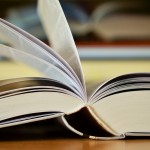MATISSE CUT-OUTS (Taschen £44.99). The recent exhibition was a huge success. “My only religion,” said Matisse, “is the love of the work to be created, the love of creation, and great sincerity.” Dancing, whirling, leaping, Matisse has an unshakable faith in the joy of living: a synthesis of colour and the arabesque, he is a soothing, calming influence on the mind, radiating serenity yet with verve. “What I dream of,” he said, “is an art of balance, of purity and tranquility, devoid of disturbing or worrying subject matter.” This is a fantastic, jaw-dropping, monumentally large format book. I cannot imagine any lover of Matisse not wanting it.
 CODICES ILLUSTRES by Ingo F Walther and Norbert Woolf. (Taschen £27.99). The world’s most famous illuminated manuscripts, European and non-European, from 400 to 1600, are brilliantly reproduced in a dazzling format and at a tremendous bargain price.
CODICES ILLUSTRES by Ingo F Walther and Norbert Woolf. (Taschen £27.99). The world’s most famous illuminated manuscripts, European and non-European, from 400 to 1600, are brilliantly reproduced in a dazzling format and at a tremendous bargain price.
With 468 pages of exquisite beauty on every page, it is an absolute delight and its beauty is quite overwhelming. Taschen has, surely, produced the definitive book on the subject?
FRANS HALS by Seymour Slive’s (Phaidon £75) is a superb edition. Hals is the first great artist of the 17th century Dutch school and it his ability with his vigorous brushwork to capture a fleeting moment which so impresses.
Not much is known about his life except for his debts. No laughing matter you would think; yet there is so much happiness in his portraits. It’s not just the cavalier who laughs.
Actually, he’s not laughing; he’s smiling. Everybody’s smiling in Rembrandt, young and old. Slive’s commentaries are extremely accessible.
 LE CORBUSIER LE GRAND (Phaidon £35) is one of the great architects, urban planners, theorists of the 20th century.”Space and light and order,” he said, “are the things that men need just as much as they need bread and a place to sleep.”
LE CORBUSIER LE GRAND (Phaidon £35) is one of the great architects, urban planners, theorists of the 20th century.”Space and light and order,” he said, “are the things that men need just as much as they need bread and a place to sleep.”
This definitive scrapbook is a visual biography on a giant scale, Brobdignagian in size and weight. Corbusier’s life and work (1887-1965) is presented in 2,000 images, photographs, documents, correspondence and newspaper clippings.
The book is essential for any student of his architecture.
 THE TREASURES OF REMBRANDT by Michel Roscam Abbing (Andre Deutsch £30) include the story of his life and work, his etchings, his engravings, his portraits, plus 20 rare removable memorabilia and documents, and these include a sketch for The Nightwatch and a map of Europe. The book has been published in a way which could whet a young person’s appetite to see the originals in their proper size. And, fortunately, there is an exhibition on now of Rembrandt’s later work at the National Gallery.
THE TREASURES OF REMBRANDT by Michel Roscam Abbing (Andre Deutsch £30) include the story of his life and work, his etchings, his engravings, his portraits, plus 20 rare removable memorabilia and documents, and these include a sketch for The Nightwatch and a map of Europe. The book has been published in a way which could whet a young person’s appetite to see the originals in their proper size. And, fortunately, there is an exhibition on now of Rembrandt’s later work at the National Gallery.
 A PAINTER’S PROGRESS A Portrait of Lucian Freud by David Dawson (Thames & Hudson £35). Dawson was Freud’s assistant, companion and model.
A PAINTER’S PROGRESS A Portrait of Lucian Freud by David Dawson (Thames & Hudson £35). Dawson was Freud’s assistant, companion and model.
He records, with dynamic photographs and quotes, the artist at work, the artist in his studio, the artist in stables, and the artist in museums: “I don’t want the painting to come from me,” said Freud. “I want it to come from them.”
The portraits and nudes, arresting and powerful in close-up, are, as any admirer of Freud knows, definitely not there to make the picture easy on the eye and more pleasant to look at.
 JEFF KOONS Conversations with Norman Rosenthal (Thames & Hudson £19.95).
JEFF KOONS Conversations with Norman Rosenthal (Thames & Hudson £19.95).
The populist consumer artist takes sexually heightened kitsch to a new scale of bad taste. (“You want to keep moving,” says Koons. “You always want art to be taking you somewhere, not showing you where you are.”)
The critics are always divided. Rosenthal thinks Koons is wonderful. But others find Koons facile, his works merely inflatable vulgarity. Duchamp would have had a good laugh.
 WHITMAN ILLUMINATED SONG OF MYSELF illustrated by Allen Crawford (Jonathan Cape £20). “I am,” said Whitman the poet of the Body and of the Soul… not the poet of goodness only.”
WHITMAN ILLUMINATED SONG OF MYSELF illustrated by Allen Crawford (Jonathan Cape £20). “I am,” said Whitman the poet of the Body and of the Soul… not the poet of goodness only.”
The text is re-imagined in graphic format. “I’ve attempted,” says Crawford, “to liberate the words from their blocks of verse and allow the lines to flow freely from the page.”
The poem is turned into a sprawling handwritten text and illustration. It is quite extraordinary. But you may feel, as I did, it would be wise to reread Whitman first. Or you might not. You may be happy just to look at each page.
 THE PAPER DOLL’S HOUSE OF MISS SARAH ELIZABETH BIRDSALL OTIS, AGED TWELVE by Eric Bowman (Thames & Hudson £14.95). Furnishing a large doll’s house is not very different from furnishing a real house. It’s a matter of taste. This late 19th century make-believe house reflects the real house in which a rich child was brought up. These exquisite and sophisticatedly naive collages, full of colourful cut-outs from contemporary advertisements and catalogues, make for a pretty album which will appeal to little girls of all ages, grannies, maiden aunts, et al.
THE PAPER DOLL’S HOUSE OF MISS SARAH ELIZABETH BIRDSALL OTIS, AGED TWELVE by Eric Bowman (Thames & Hudson £14.95). Furnishing a large doll’s house is not very different from furnishing a real house. It’s a matter of taste. This late 19th century make-believe house reflects the real house in which a rich child was brought up. These exquisite and sophisticatedly naive collages, full of colourful cut-outs from contemporary advertisements and catalogues, make for a pretty album which will appeal to little girls of all ages, grannies, maiden aunts, et al.
You can buy your copies of any of these books by clicking on the images below:





